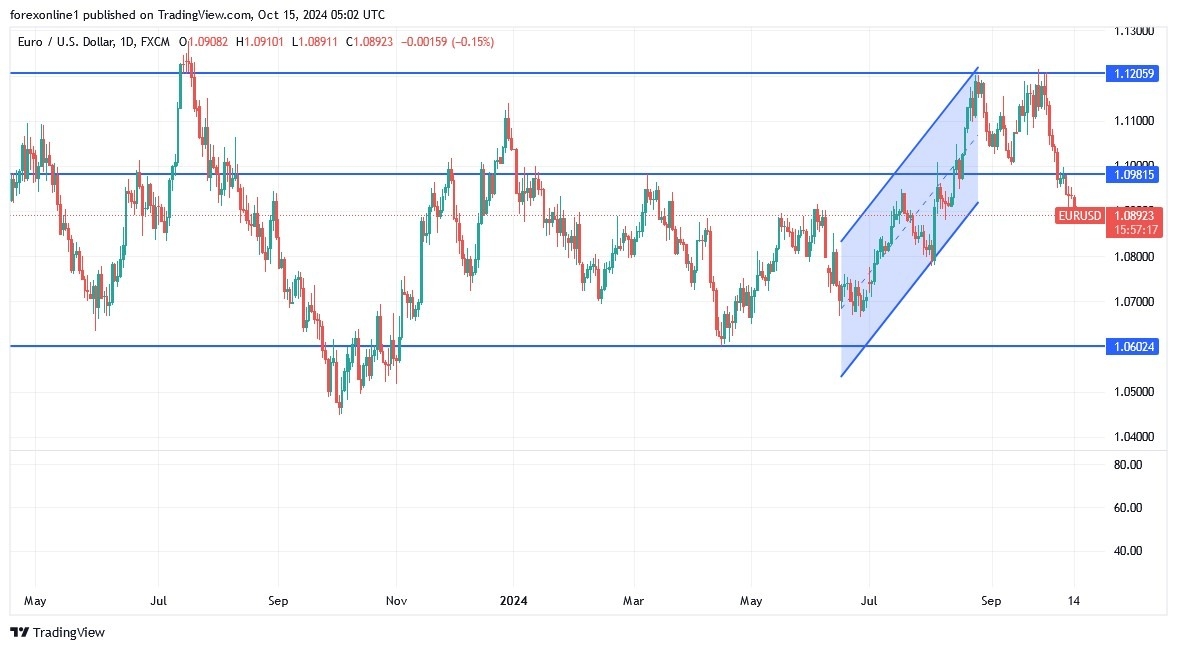- At the beginning of this week, the euro continued to decline, reaching a support level of $1.0887, its lowest level in two months.
- This is due to the divergence in monetary policies between the European Central Bank (ECB) and the US Federal Reserve.
- The ECB is expected to cut its deposit rate by 25 basis points this Thursday, following cuts made in September and June.
- Traders expect further cuts at each meeting until March, reflecting the ECB’s response to slowing inflation, which fell to 1.8% in the eurozone, its lowest level since April 2021.
- In contrast, stronger-than-expected US jobs and inflation data have reduced bets on further large interest rate cuts by the Federal Reserve, maintaining pressure on the euro.
After the cut in September, the ECB was expected to cut interest rates again in 2024 at its December meeting.
However, the data and events simply won’t allow for such a modest approach from policymakers in Frankfurt: Since the September decision, we’ve seen unexpectedly weak inflation data and further confirmation that Germany’s economy is at risk of slipping into recession. Add to that a severe fiscal shock in France, where the government last week announced billions of euros in spending cuts and tax increases. Furthermore, the eurozone economy is simply not at the inflationary level it was just six months ago.
Amid the weakness of the euro against the US dollar and the downward momentum expected, it’s worth considering. First, the US dollar is losing some steam. Let’s not forget the US dollar side of the equation, which has arguably been the dominant force in the EUR/USD decline. Moreover, the US dollar surged in October as markets pared back expectations of the size of interest rate cuts over the rest of 2024 thanks to better-than-consensus US economic data releases. Obviously, the US economy doesn’t need an urgent pace of rate cuts. Also, the downgrade has boosted US bond yields and the dollar. But the move appears to have run its course in the short term, with financial markets now expecting less than two more 25bp cuts over the rest of the year.
Is that possible? No, say economists who believe the Fed is still on track to deliver two more cuts. “It seems to me that the rise in US yields has run its course, and what we will continue to see is a turbulent FX market rather than a volatile one,” says Kit Juckes, head of FX analysis at Société Générale. “Next month’s jobs report will be spoiled by hurricanes, which would justify a 25bp cut rather than a pause, in my view.”
Second, the ECB’s interest rate cut is part of the price of the euro and will not be a surprise event. “Sell the rumours, buy the fact” is a likely reaction to this week’s meeting.
Meanwhile, the ECB will point to the cut as confirmation that it is proactive on interest rates and that this could allow it to assess incoming data. This implies a steady pace of cuts going forward, with limited opportunity for the market to re-price expectations strongly towards an acceleration in the pace of cuts.
EUR/USD Technical analysis and forecast:
The EUR/USD exchange rate is expected to test the 200-day moving average as sellers look forward to the ECB’s interest rate cut this Thursday. The realization that the ECB will move again has contributed to the decline of the EUR/USD pair below 1.10, and the next main target is the 200-day moving average located at 1.08736.
We put a high probability of testing such a level at some point during the remainder of October. From the expected support level, technical indicators may begin to move towards oversold levels. After that, the most important support on the daily chart will be the 1.0775 support level. Conversely, on the same time frame, the current downward channel will not be broken without returning to the vicinity of the 1.1070 resistance.
Ready to trade our EUR/USD Forex analysis? We’ve made a list of the best forex demo accounts worth trading with.






















